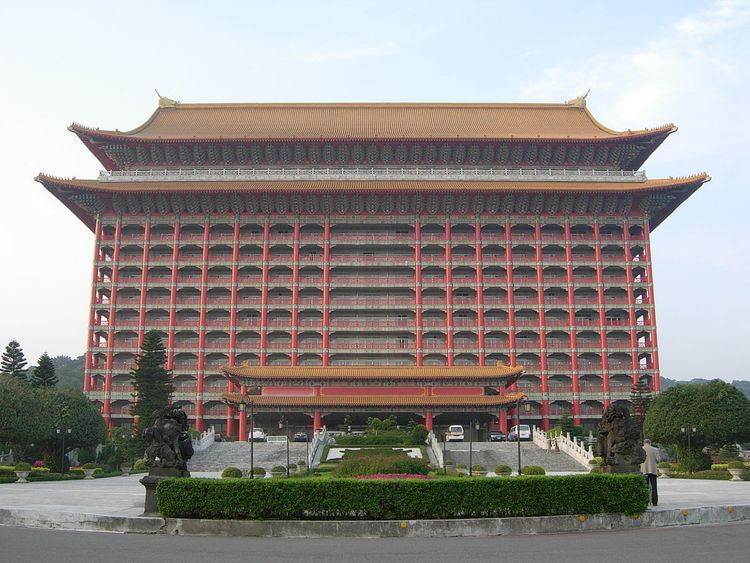Floor count 12 (main building) | Architect Yang Cho-cheng | |
 | ||
Location 1, Chung Shan N.Rd., Sec.4, Zhongshan District, Taipei, Taiwan Opening May, 1952 (main building: October 10, 1973) Owner Ministry of Transportation and Communications Management Taiwan Friendship Foundation (Duen-Mou Foundation) | ||
The Grand Hotel (Chinese: 圓山大飯店; pinyin: Yuánshān Dà Fàndiàn; literally: "Yuanshan Great Hotel"), is a landmark located at Yuanshan (圓山) in Zhongshan District, Taipei, Taiwan. The hotel was established in May 1952 and the main building was completed on October 10, 1973. It is owned by the Duen-Mou Foundation of Taiwan, a non-profit organization, and has played host to many foreign dignitaries who have visited Taipei.
Contents
The main building of the hotel is one of the world's tallest Chinese classical buildings, it is 87 metres (285 ft) high. It was also the tallest building in Taiwan from 1973 to 1981.
History
After Chiang Kai-shek's retreat to Taiwan in 1949, Chiang felt it was difficult to accommodate foreign ambassadors due to the lack of five-star hotels in Taipei. He wanted to build an extravagant hotel that would cater to foreign guests. His wife Soong Mei-ling (Madame Chiang) suggested to build it on the old Taiwan Hotel on Yuanshan Mountain, the site of the ruins of the Taiwan Grand Shrine, a Shinto shrine during the Japanese rule. Chiang decided on a Chinese palace-style architecture to promote Chinese culture to the West through its extravagance. Taipei-based architect Yang Cho-Cheng was responsible for the design of the new hotel.
The hotel was established in May 1952, but it was expanded several times before it became the landmark it is known as today. The swimming pool, tennis court, and the membership lounge were constructed in 1953, and the Golden Dragon Pavilion and Golden Dragon Restaurant opened in 1956. The Jade Phoenix Pavilion and Chi-Lin Pavilion opened in 1958 and 1963, respectively. In 1968 the hotel was rated as one of the world's top ten hotels by the US Fortune magazine. Finally, on the Double Tenth Day of 1973, the main Grand Hotel building was completed and became an instant Taipei icon.
In June 1995 a disastrous fire broke out on the roof of the main building during necessary reconstruction and refurbishment. As neither ladders nor high pressure pumps could reach the fire, the roof and the upper floors were destroyed. Not until 1998 did the hotel recover from the damage and became fully reopened to the public. Following the fire, the two dragon heads on the roof were rotated 180 degrees to point inwards. As dragons are traditionally a symbol of rain and water, this was intended to symbolize preparedness against a future fire.
General features
With its vermilion columns, the roof makes the hotel a visible showplace of Chinese architecture and culture. The hotel itself contains numerous objets d'art, wall panels, paintings, carvings, and significant restaurants. Dragon motifs are frequently intertwined throughout the various structures that make up the hotel, earning the hotel the name "The Dragon Palace". Beside dragons, lion and plum flower motifs also make a significant presence in the hotel.
Each of the eight guest levels represent a different Chinese dynasty, as reflected through the murals and general decor. The hotel has a total of 490 rooms. The rooms facing south offer guests a paranomic view of Taipei City. The presidential suite, as the hotel claims, has former President Chiang Kai-shek's desk and Madame Chiang's dressing table. Currently, the presidential suite costs NT$160,000 per night (Approx. $4,850). Budget rooms are available from ca. $99 per night.
The hotel also features auditoria and meeting rooms, making it a popular venue for conventions and conferences in Taiwan.
Secret passages
Ever since the opening of the hotel, rumour had it that secret passages ran from the hotel to the nearby Shilin Official Residence and further Presidential Office Building for Chiang's convenience. The truth was uncovered after the 1995 fire, as part of the safety commission that was conducted. The secret passages were revealed to be two air-raid tunnels, each of them 180m in length leading to nearby parks, not to the presidential residence or the emergency headquarters as rumours had suggested. The western passage is equipped with a slide for the disabled as an alternative to the spiraling stairs. The exits are obscured with concrete walls, thus escaping public detection for decades. The tunnels have a maximum capacity of about 10,000 people.
As of 2005 the tunnels were closed to the public except for special events, when hotel officials invite the press and public inside the tunnels for a tour.
